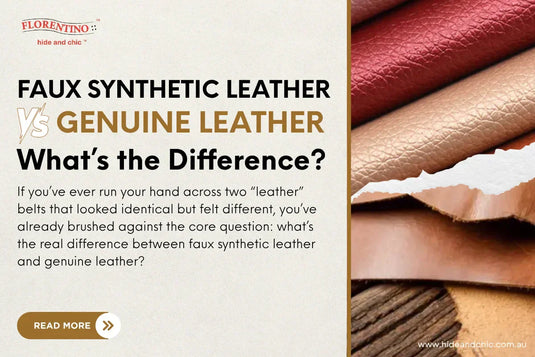If you’ve ever run your hand across two “leather” belts that looked identical but felt different, you’ve already brushed against the core question: what’s the real difference between faux synthetic leather and genuine leather?
In an age when sustainability, fashion, and ethics collide, this isn’t a simple debate. Faux synthetic leather has gained popularity for its affordability and vegan appeal, while genuine hides remain the benchmark for longevity and texture.
But looks can deceive. Let’s separate the myths from the material and see how each option performs, ages, and justifies its price, especially when you’re about to buy genuine leather belts.
What is Faux Synthetic Leather, Really?

Faux Synthetic Leather is not leather at all. It’s a man-made fabric, usually polyurethane (PU) or polyvinyl chloride (PVC), layered and embossed to imitate natural grain.
Manufacturers use heat and pressure to stamp a leather-like texture onto a plastic base.
The result? Smooth, shiny, and consistent, but entirely artificial.
That’s why it’s sometimes called Artificial Leather. It doesn’t breathe, age, or repair like animal hide. Instead, it cracks, peels, and flakes with time, especially under heat or moisture.
In short, faux synthetic leather offers the look but not the life.
How Genuine Leather Is Made

Now let’s look at the real thing.
Genuine leather comes from animal hides (mostly cow, buffalo, or goat) that undergo tanning to prevent decay and strengthen the fibres.
The best hides are vegetable-tanned, a slow, natural process using plant extracts instead of industrial chemicals.
This preserves the grain, giving genuine leather that unmistakable scent, texture, and endurance.
The difference between genuine leather vs fake leather starts here, the fibre structure.
Real leather breathes and adapts to its environment. Synthetic versions, being sealed plastics, cannot.
When you wear a full-grain belt from Hide & Chic, you’ll feel the difference immediately. It’s soft, flexible, and never sticky to the touch.
Comparing Feel, Durability, and Longevity
|
Feature |
Faux Synthetic Leather |
Genuine Leather |
|---|---|---|
|
Material Base |
Plastic (PU or PVC) |
Animal hide |
|
Texture |
Smooth and uniform |
Natural, varied grain |
|
Smell |
Chemical or neutral |
Earthy and organic |
|
Durability |
6–12 months before cracking |
10+ years with care |
|
Aging |
Deteriorates over time |
Develops rich patina |
|
Repairability |
Cannot be repaired |
Can be conditioned and restored |
|
Price Range (Belts) |
$20–$50 |
$30–$150+ depending on leather grade |
As the table shows, Faux Synthetic Leather wins only on short-term affordability.
However, in terms of comfort, sustainability, and lifespan, genuine leather vs. fake leather isn’t even close.
The Environmental Question: Is Artificial Leather Really Eco-Friendly?
The marketing of Artificial Leather often leans on the word “vegan,” suggesting it’s automatically sustainable.
But that’s not always true.
Most faux leathers are made from plastic polymers derived from petroleum. They don’t biodegrade and can release microplastics over time.
In contrast, vegetable-tanned genuine leather is biodegradable and often sourced as a by-product of the meat industry. It lasts longer and requires fewer replacements, which lowers total environmental impact.
This is where craftsmanship, not chemistry, defines sustainability.
The Price Illusion
When you buy a belt, price feels like a quick indicator of quality — but it’s not the full story.
A faux synthetic leather belt might cost less upfront, but it often needs replacing every year or two.
Meanwhile, when you buy genuine leather belts, you’re paying for decades of use, not months.
Think of it as cost per wear.
|
Material |
Average Price Range |
Expected Lifespan |
Cost Per Year |
|---|---|---|---|
|
Faux Synthetic Leather |
$30 |
1 year |
$30 per year |
|
Genuine Leather (Full-Grain) |
$90 |
10 years |
$9 per year |
That’s the math of long-term value — genuine leather always wins.
Touch, Smell, and the Human Test
Here’s how you can identify real leather without labels or fancy packaging:
-
Touch it: Real leather feels warm, slightly grainy, and flexible. Faux Synthetic Leather feels colder and smoother.
-
Smell it: Genuine leather carries a deep, organic scent. Artificial versions smell of plastic or chemicals.
-
Press it: When you press a finger into genuine leather, it wrinkles slightly and recovers. Faux stays flat.
-
Burn test (for curiosity, not practice): Real leather smells like burnt hair; synthetic smells like burning plastic.
If you ever plan to buy genuine leather belts, these small details save you from marketing traps.
Maintenance: How Each Material Ages
Genuine Leather:
-
Gets softer with time
-
Develops patina
-
Can be cleaned and reconditioned
Faux Synthetic Leather:
-
Loses flexibility over time
-
Cracks under pressure
-
Cannot be repaired once damaged
That’s why genuine leather vs fake leather isn’t a contest of appearance, but of time. Real leather tells a story; faux leather simply expires.
When Faux Synthetic Leather Still Makes Sense
To be fair, faux synthetic leather has its uses. For lightweight accessories, short-term fashion, or those avoiding animal products entirely, it’s a reasonable choice.
It’s also more uniform in colour and texture, which some designers prefer.
However, for daily-wear items like belts, wallets, or shoes, longevity is crucial, and that’s where genuine leather remains unmatched.
Feel the Difference, Don’t Just See It
At first glance, faux synthetic leather can fool the eye. But once you wear it daily, the difference becomes obvious; comfort, scent, and texture are worlds apart.
The real beauty of genuine leather is its honesty. It breathes, bends, and grows better with you. It doesn’t just survive; it evolves.
That’s what makes every Hide & Chic piece a small act of craftsmanship in a fast-fashion world.
Experience the Genuine Leather Longevity
 Before you buy genuine leather belts, take a moment to feel the surface, check the stitching, and notice the scent.
Before you buy genuine leather belts, take a moment to feel the surface, check the stitching, and notice the scent.
That quick inspection tells you more than any label ever will.
Explore Hide & Chic’s handcrafted leather collection and see how authenticity feels when design meets honest material.
Visit Hide & Chic Australia to experience the real thing.
FAQs About Faux Synthetic Leather
1. Is Faux Synthetic Leather Vegan?
Yes, but most are petroleum-based. Not all vegan materials are environmentally friendly.
2. Can Artificial Leather Last Long?
Usually not. Even the best Artificial Leather peels or cracks within two years of heavy use.
3. Why Do Genuine Leather Products Cost More?
Because tanning and finishing are time-consuming processes that preserve the material’s strength and natural beauty.
4. How Can I Buy Genuine Leather Belts That Are Ethically Made?
Choose local Australian brands, such as Hide & Chic, that utilise vegetable-tanned hides and employ small-batch production methods.
5. Are All Genuine Leather Belts the Same?
No. Look for full-grain or top-grain. Bonded leather is technically real, but it is much weaker.




